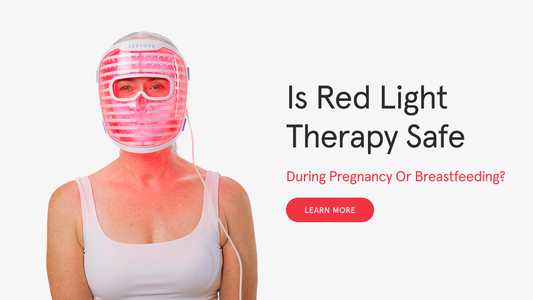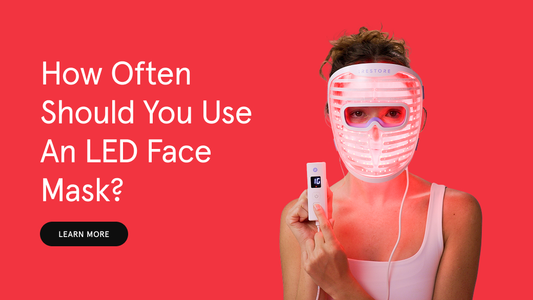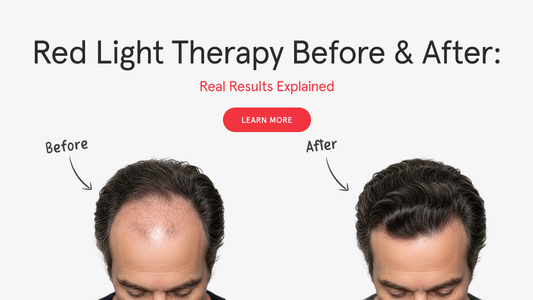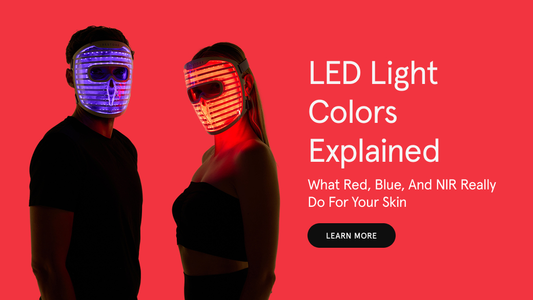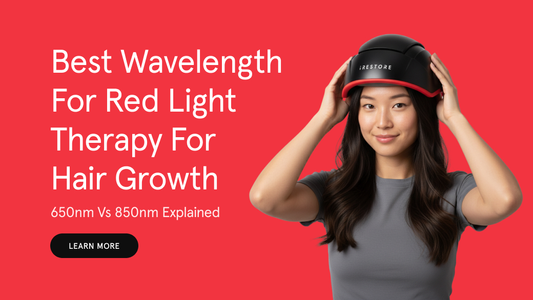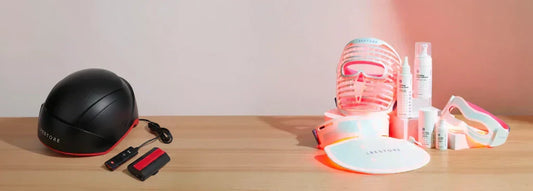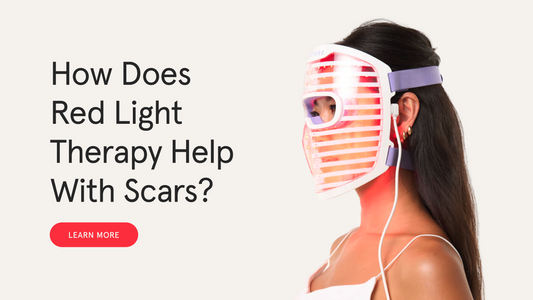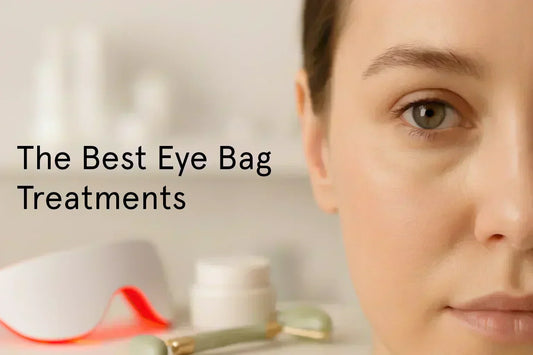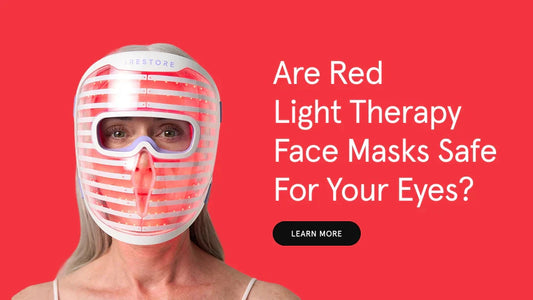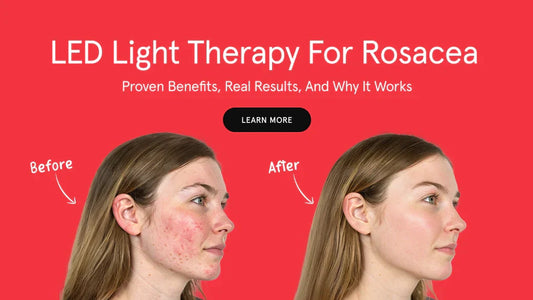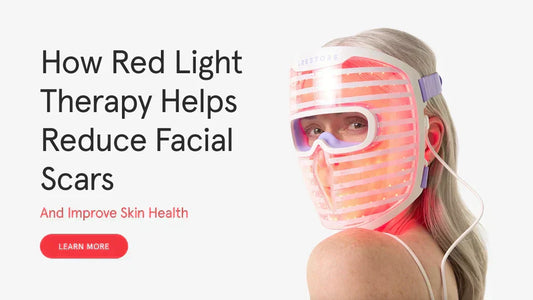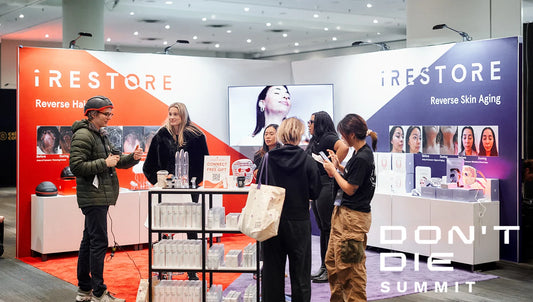The iRESTORE Blog
Confidence Starts Here
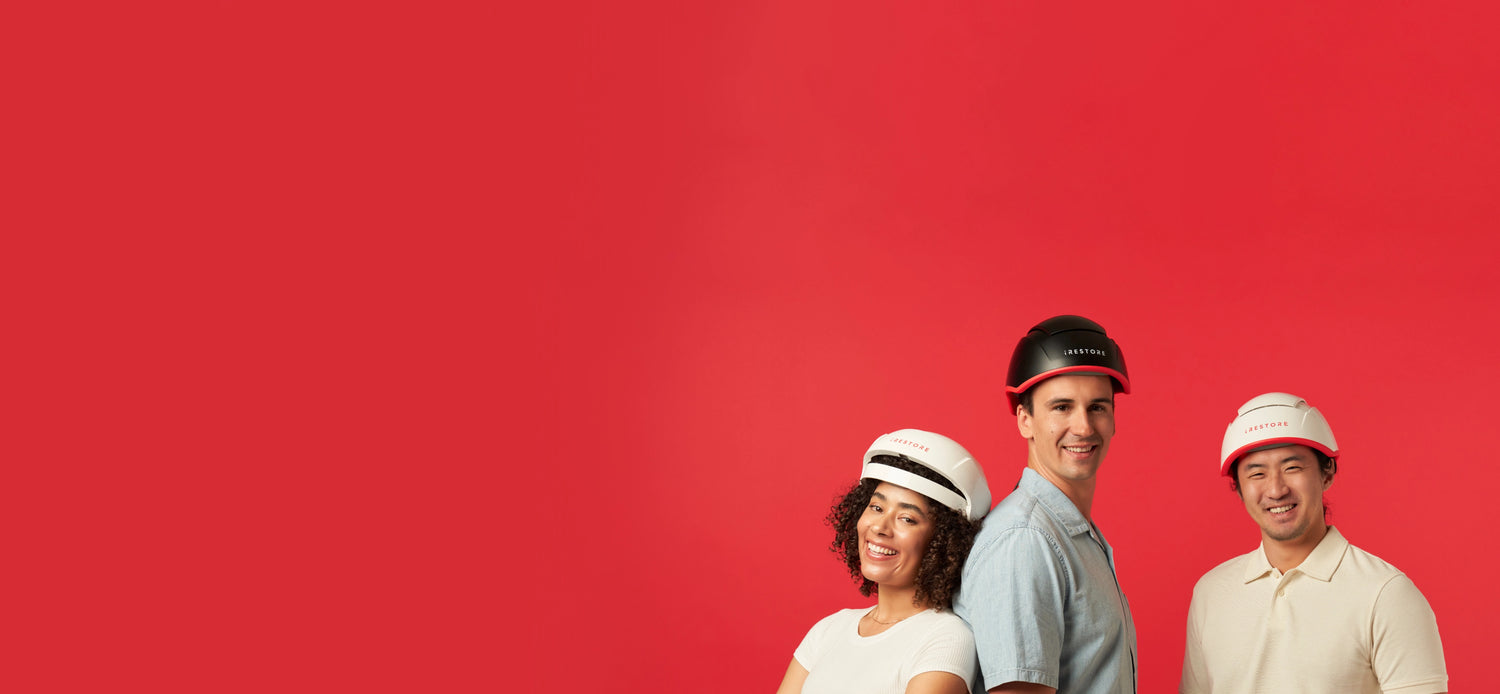

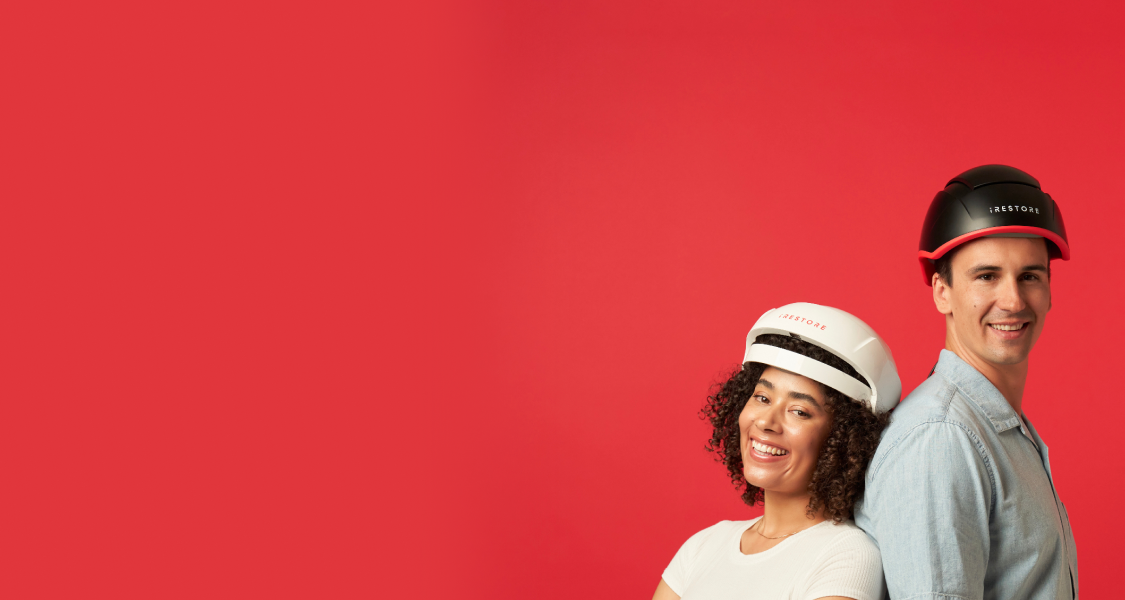

12 Results
Is Red Light Therapy Safe During Pregnancy or Breastfeeding?
Red light therapy (RLT) is everywhere, used for skin recovery, pain relief, and post-procedure healing. But pregnancy and breastfeeding are unique stages where “generally safe” isn’t good enough; you need clear, responsible guidance. This article answers the question “is red light therapy safe during pregnancy?” by combining what’s known about how RLT works with what’s not yet proven in pregnant and nursing populations. You’ll get a balanced view of current science, expert caution, and practical safeguards, so you can make an informed decision with your clinician. Important: This article is educational and not medical advice. Always consult your OB-GYN or dermatologist before starting any light-based therapy while pregnant or breastfeeding. What Is Red Light Therapy and How Does It Work? Red light therapy uses low-level wavelengths of light, usually between 630–850 nanometers to support skin health, reduce inflammation, and promote tissue repair, benefits also seen in LED light therapy for rosacea and general skin rejuvenation. Unlike UV light, it’s non-ionizing and doesn’t cause burns or DNA damage. Because it works by gently stimulating cellular energy and blood flow, it’s considered safe for most people. However, during pregnancy and breastfeeding, even non-invasive therapies need closer examination, mainly to confirm where and how they can be used safely. Why People Consider Red Light Therapy During Pregnancy and Breastfeeding Pregnancy and postpartum recovery often come with back pain, swelling, fatigue, and skin changes and many women look for non-drug, gentle ways to manage them. Red light therapy appeals because it’s non-invasive and may help with: Relieving joint or muscle pain Supporting skin elasticity and healing Reducing inflammation and swelling Improving mood and energy levels While these benefits make it an attractive option, pregnancy and breastfeeding require extra caution. Hormonal and skin sensitivity changes mean that what’s safe for general use may not be safe during these stages. What Science and Experts Say About Red Light Therapy in Pregnancy and Breastfeeding Current research shows that red light therapy is generally safe for the skin, but studies specifically involving pregnant or breastfeeding women are limited. Most of what we know comes from broader research on non-ionizing light therapies used in dermatology and wound care. A 2021 review in Lasers in Medical Science found that low-level laser and LED treatments caused no harmful effects when used on the skin during pregnancy (PubMed Central, 2021). Similarly, the LactMed database from the U.S. National Library of Medicine lists light-based therapies as compatible with breastfeeding, provided they’re used away from the breast or nipple area. Experts, however, agree on one key point, lack of pregnancy-specific research means caution is necessary. Midwives and dermatologists typically recommend: Avoiding direct light exposure on the abdomen, uterus, and breasts. Limiting sessions to short, localized use (face, neck, legs). Using only FDA-cleared devices and seeking medical approval first. Current evidence suggests that red light therapy is likely safe when used responsibly, but until more targeted studies are done, it’s best to proceed under professional guidance. Safe Use Guidelines for Pregnancy and Breastfeeding Red light therapy can be a gentle addition to a wellness routine but pregnancy and breastfeeding require extra care. Hormonal changes and increased skin sensitivity can make your body react differently, so how and where you use light therapy truly matters. Here’s what experts and dermatologists recommend: Keep treatments localized. Use red light only on smaller areas such as the face, neck, or legs. Avoid sensitive regions. Steer clear of the abdomen, uterus, lower back, and breasts during pregnancy and nursing. Limit session time. Short sessions of about 10–15 minutes are enough; overuse doesn’t improve results. Choose medically tested devices. Look for FDA-cleared red or near-infrared devices (typically 630–850 nm range), and refer to our guide on how often to use red light therapy for hair growth for safe usage frequency and dosage insights. Pay attention to your skin. Stop immediately if you experience redness, warmth, or discomfort. Consult your OB-GYN or dermatologist before starting or resuming therapy, especially if you’re taking medication or have sensitive skin. Avoid use altogether in high-risk pregnancies, cases of skin infection, or when using photosensitizing drugs. For breastfeeding mothers, never apply light directly over the breast or nipple area. Using it on non-chest areas is generally considered low risk, but always confirm with your healthcare provider first. Red light therapy may be safe when used responsibly but during pregnancy and postpartum, it’s always best to take a cautious, doctor-guided approach. Conclusion: Safety First, Always Red light therapy is gentle and non-invasive, but during pregnancy and breastfeeding, it should be used with care, similar caution applies to red light therapy face masks and eye safety. Current research shows it’s likely safe for localized use, though data on pregnant and nursing women is still limited. Always avoid direct exposure on the abdomen, uterus, or chest, and get your doctor’s approval before starting. Choosing FDA-cleared devices, like those from iRESTORE, ensures you’re using clinically tested wavelengths designed for safe, at-home use. When used responsibly, red light therapy can support skin health and recovery; just make safety your first priority. FAQs Can I use red light therapy on my face while pregnant? Yes, using red light therapy on the face or neck is generally considered low risk when sessions are short and performed with FDA-cleared devices. Always confirm with your OB-GYN before starting. Are there any side effects of using red light therapy during pregnancy? Mild redness or warmth may occur temporarily, but serious side effects are rare. Skin sensitivity can increase during pregnancy, so start slowly and discontinue use if irritation occurs. What should I look for in a safe red light therapy device? Choose an FDA-cleared device with wavelengths between 630–850 nm, a built-in timer, and tested safety standards like those used in iRESTORE’s clinically validated systems. Disclaimer: The iRESTORE blog is for informational purposes only and is not intended to replace professional medical advice or treatment. Please do not ignore professional guidance because of information you’ve read here. If you have concerns about your hair or skin health, we encourage you to consult a qualified healthcare professional.
Read More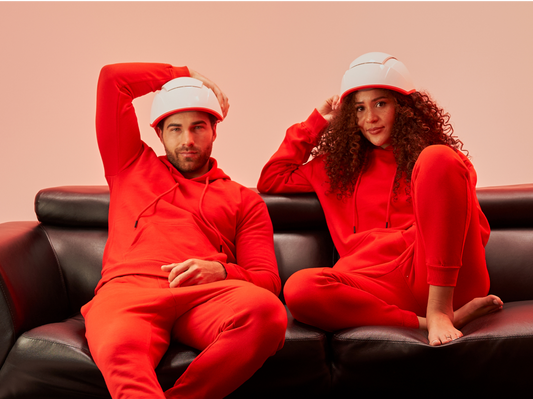
About iRESTORE
We believe in safe & clean hair care that empowers you to look and feel your best without compromising your health.
How Often Should You Use an LED Face Mask?
LED face masks have become a skincare favorite, promising brighter, firmer, and clearer skin from the comfort of home. But one question keeps coming up: how often should you use an LED face mask to actually see results? The answer isn’t just about using it more often. It’s about understanding how light interacts with your skin and giving your cells enough time to respond. Use it too little, and you won’t see much change. Use it too often, and your skin may feel dry or overstimulated. The right frequency depends on your skin goals, device strength, and light wavelength whether you’re targeting acne, dullness, or fine lines. In this article, we’ll break down exactly how often to use your LED face mask safely, what signs of overuse to watch for, and how to build a routine that delivers visible, lasting results. How LED Face Masks Work LED face masks use light energy not heat or chemicals to trigger natural repair processes in your skin. Each color of light penetrates to a different depth and activates specific cellular responses: Red light (630–660 nm): Improve collagen production, reduces fine lines, and promotes elasticity, the same principle behind red light therapy for hair growth. Blue light (415–450 nm): Targets acne-causing bacteria and calms inflammation. Near-infrared (800–850 nm): Supports circulation and deeper tissue recovery. The process is called photobiomodulation, light absorbed by skin cells increases energy (ATP) and enhances regeneration. What really matters is consistency. LED therapy works gradually; it needs regular use to build results. Overdoing it, on the other hand, won’t accelerate progress, it can leave your skin feeling dry or irritated. How Often to Use an LED Face Mask You don’t need to use an LED face mask every day to get results but you do need to use it consistently. Most experts agree that three to five sessions per week is ideal for at-home use, similar to recommendations in LED light therapy colors and their effects and red-light studies. Each session should last about 10 to 20 minutes, depending on your device’s intensity and your skin’s tolerance. Using it more frequently won’t make results appear faster in fact, it can leave your skin feeling tight or overly dry. Here’s a quick breakdown based on your routine and goals: If You’re Just Starting Out Start slow, about 3 times a week. This gives your skin time to adjust to the light exposure. After two to three weeks, you can gradually increase to four or five sessions if your skin feels comfortable. If You’re Targeting Acne For acne-prone skin, blue light therapy works best when used regularly. You can use it 4–5 times a week for 10–15 minutes per session. Once your breakouts are under control, reduce to 2–3 times weekly for maintenance. If You’re Focused on Anti-Aging or Collagen Boosting For firming and wrinkle reduction, red light therapy shows great results with 3–4 sessions a week. The benefits build over time as your skin produces more collagen and elastin, so steady use matters more than daily intensity. If You’re Maintaining Results Once your skin is balanced, reduce sessions to 1–2 times per week. Think of it like a workout: maintenance keeps your progress steady without overstimulating your skin. Why Daily Use Isn’t Necessary LED therapy works by triggering biological responses, it gives your skin cells energy, but they still need time to rest and rebuild. Overusing the mask won’t speed things up; it can actually slow results by overloading the skin barrier. Use your LED face mask 3–5 times per week for 10–20 minutes. Be consistent, not aggressive, your skin needs rhythm, not repetition. Signs You’re Overusing an LED Face Mask With LED light therapy, balance is everything. Using your mask regularly delivers great results but giving your skin time to recharge is just as important. Here are a few ways your skin might tell you it needs a short break: Your skin feels a little tight or less hydrated than usual. You notice a bit more warmth or flushing after a session. Your glow seems to have plateaued, even with daily use. If that happens, simply space your sessions a little farther apart or shorten the duration. Your skin thrives when it’s gently stimulated and allowed time to respond between treatments. Consistency, not frequency, is what keeps your results long-lasting and healthy-looking. How Long Before You See Results LED light therapy works gradually, your skin needs time to renew and rebuild from within. Most users start noticing a visible glow and smoother texture after about 3 to 4 weeks of consistent use. For deeper changes like improved firmness, fewer fine lines, or a clearer tone, results typically appear within 6 to 8 weeks. That timeline is reflected in real user experiences, too. Kenny S., a verified buyer, shared: “I’ve been using this LED mask for 4 weeks now, and I love it! The wrinkles around my eyes and jowls are so much less noticeable—I love how lightweight and comfy it is. I can fold laundry or do other things around the house while wearing it. It only takes 10 minutes a day. I wish I would have bought this one first—I would have saved a lot of money.” Results like these show that consistency, not intensity, drives visible improvements. With steady use, most people see progressive changes week after week, healthier, smoother, and more radiant skin that lasts. Best Practices for Safe, Effective LED Use A few simple habits can make your LED mask sessions safer and more effective — helping your skin get the most from every use. Start with clean skin. Remove makeup, sunscreen, and oil before each session. Follow the timer. Most masks work best with 10–20 minutes per session, longer isn’t necessary. Stay consistent. Use your mask on a set schedule, a few times per week, for steady results. Hydrate after use. Apply a lightweight serum or moisturizer to support recovery. Use trusted devices. Choose FDA-cleared LED masks, like those from iRESTORE, to ensure safe, clinically tested light levels, just as you would for at-home red light therapy for skin repair. With the right routine, LED light therapy becomes a simple, relaxing step in your weekly skincare, one that delivers visible, lasting results. Conclusion When it comes to LED light therapy, consistency always beats intensity. Using your mask a few times a week, not every day, gives your skin the right balance of stimulation and recovery time. Within a few weeks, you’ll notice smoother texture, better tone, and that healthy, lasting glow. If you’re looking for a device that’s FDA-cleared, comfortable, and clinically validated for daily use, the iRESTORE Illumina LED Face Mask is designed exactly for that purpose. It makes it easy to build a safe, effective LED routine right at home. Commit to a schedule that works for your skin, stay consistent, and let the light do the rest. FAQs About LED Face Mask Usage Can I use an LED face mask after applying skincare products? It’s best to use your LED mask on clean, dry skin so the light can penetrate effectively. Apply serums or moisturizers after your session, especially hydrating or antioxidant-rich products. Should I use my LED mask in the morning or at night? Both are fine, but many people prefer using it at night since skin repair naturally happens while you sleep. Evening sessions also help calm redness and prep skin for rest. Is LED light therapy suitable for sensitive skin? Yes. LED light therapy is gentle and non-invasive, making it safe for sensitive or rosacea-prone skin. Start with shorter sessions (5–10 minutes) to see how your skin responds. Disclaimer: The iRESTORE blog is for informational purposes only and is not intended to replace professional medical advice or treatment. Please do not ignore professional guidance because of information you’ve read here. If you have concerns about your hair or skin health, we encourage you to consult a qualified healthcare professional.
Read MoreRed Light Therapy Before & After: Real Results Explained
Red light therapy is one of the few non-invasive treatments clinically shown to support natural hair regrowth also used in skin rejuvenation treatments at home for improving texture and tone. Using wavelengths between 630–850 nm, it stimulates hair follicles, boosts circulation, and helps dormant follicles grow stronger, healthier strands. Results take time, most users notice visible changes after 3–6 months of consistent use. In this article, we’ll look at real before-and-after results, what to expect along the way, and how FDA-cleared devices like iRESTORE help make those results possible. Red Light Therapy Hair Growth Before and After (Real User Results) Seeing is believing and when it comes to red light therapy, the results speak for themselves. Across thousands of users, consistent use over several months has led to stronger, fuller, and healthier-looking hair, visible in both real photos and clinical trials. Red light therapy works by energizing the hair follicle cells through specific wavelengths (around 650 nm), similar to how red light therapy helps reduce facial scars and improve tissue healing. This improves blood circulation, increases ATP production, and reactivates dormant follicles that were previously in the resting phase. The outcome? Noticeably thicker strands and renewed hair growth in areas of thinning or shedding. In controlled studies, participants using FDA-cleared devices like iRESTORE reported up to a 35% increase in hair count after 16 to 24 weeks of consistent use, similar findings have been seen in how often to use red light therapy for hair growth. The change is often gradual, reduced shedding first, followed by denser coverage and improved scalp health but it becomes remarkably clear when tracked month over month. Below are three real user stories that show what this progress looks like in practice: Alyssa, 34 — Widening Parts “Tired of my widening part, I tried this device. Six months later, my hair is stronger and thicker. Worth every penny!” In just 6 months, Alyssa noticed visible improvement in her part line, reduced breakage, and a healthier scalp environment that supported new hair growth. Albert, 37 — Thinning Crown “I’ve been using the device for six months. I’m seeing significant growth in my crown. Keep up the routine and you’ll see growth!” Albert’s consistency paid off — the crown area, typically slow to respond, showed clear thickening and coverage within 6 months. Emma, 48 — Bald Spots “I’ve consistently used the device for 18 months. Massive growth! As long as you are consistent, the results will come!” Emma’s results reflect long-term dedication. Over 18 months, she saw steady filling in previously sparse areas, proving that consistency is the key to success. These transformations show what’s possible when science meets commitment. To see more real users who’ve experienced visible changes with iRESTORE, visit the full Before & After Results Gallery. The Hair Growth Timeline: What to Expect Month by Month Red light therapy results build gradually, it’s a process of restoring follicle activity and strengthening your hair from the roots up. Understanding what happens at each stage helps set the right expectations and keeps you motivated to stay consistent. Weeks 1–4: Early Cellular Repair In the first few weeks, most users don’t see visible changes yet but the foundation is forming. The light stimulates energy production (ATP) inside your hair follicle cells, increasing blood flow and reducing inflammation around the scalp. You may notice less shedding and a healthier scalp environment. Weeks 4–12: Reduced Shedding and Stronger Strands As follicles begin to repair, shedding starts to slow. You might feel new, soft “baby hairs” emerging, or notice that existing strands feel thicker and stronger. This phase often builds confidence, small but real progress starts showing in mirror photos. Months 3–6: Noticeable Regrowth This is when most people start seeing visible results, new hair filling in thinning areas, a denser crown, or a more even hairline. Clinical studies have shown up to 35% more hair density within this window for consistent users. 6+ Months: Full Growth and Maintenance By this point, follicles are active and producing new hair regularly. Users often notice richer texture, stronger strands, and improved scalp coverage. Continued use maintains these results and helps prevent future thinning. Consistency beats intensity. Using an FDA-cleared device like iRESTORE three to four times a week yields sustainable, long-term improvement with each month building on the last. What Impacts and Improves Your Results Your results with red light therapy depend on a few key factors and the good news is, most of them are within your control. Consistency is everything. Use your device 3–4 times per week for at least a few months. Hair growth is a slow biological process, steady use makes all the difference. Device quality matters. FDA-cleared systems like iRESTORE use clinically validated wavelengths (~650 nm) proven to stimulate follicles safely and effectively. Healthy scalp, healthy growth. A clean scalp allows better light absorption, adding techniques like how to massage your scalp for hair growth can further improve results. Patience pays off. Most users see visible change around 3–6 months, with continued thickening after that. Combine smartly. Supplements like biotin or topical serums can complement red light therapy when used responsibly. Use the right device, stay consistent, and give your scalp the environment it needs to thrive, that’s the formula behind every great before-and-after story. Conclusion: Real Results Come from Real Consistency Red light therapy delivers visible, lasting results but only when you give it time to work. Hair regrowth is a gradual process, and consistency makes all the difference. Most users begin noticing stronger, thicker hair within 3–6 months, with continued improvements over time. The key is to stay patient and use an FDA-cleared device like the iRESTORE Laser Hair Growth System Elite, which delivers clinically tested wavelengths proven to safely reactivate dormant follicles and support healthy regrowth. Every before-and-after story starts the same way with a few short sessions a week and a commitment to keep going. Stay consistent, and your next photo could be the “after” someone else looks up to. FAQs Can red light therapy reverse hair thinning? Yes, it can slow or reverse early-stage thinning by strengthening active follicles and reactivating dormant ones. Results depend on consistency and stage of hair loss. Do before-and-after results differ for men and women? Both men and women experience improvements, though thinning patterns differ. Women often see fuller coverage across the crown, while men notice denser regrowth around the hairline and crown. Are the results from red light therapy permanent? Results can last as long as you continue using your device. Like exercise, consistent use maintains progress, while stopping treatment may allow hair thinning to resume. Can I combine red light therapy with other treatments like minoxidil or supplements? Yes, many users combine it with biotin, DHT blockers, or minoxidil for added support. Always check with a dermatologist before starting combined treatments. How do I track my red light therapy progress? Take clear scalp photos every 4 weeks in consistent lighting and angles. Comparing these side-by-side helps you see gradual improvements over time. Disclaimer: The iRESTORE blog is for informational purposes only and is not intended to replace professional medical advice or treatment. Please do not ignore professional guidance because of information you’ve read here. If you have concerns about your hair or skin health, we encourage you to consult a qualified healthcare professional.
Read MoreLED Light Colors Explained: What Red, Blue, and NIR Really Do for Your Skin
Ever wondered what the colors on your LED mask actually do? Red for wrinkles, blue for acne, near-infrared for healing, each color targets your skin in a different way. LED light therapy works by using specific wavelengths of light to activate natural repair processes in your skin, similar to the way red light therapy helps reduce facial scars by stimulating regeneration. Knowing which LED light therapy colors address your goals helps you get real, visible results, not just glowing promises. This article breaks down what red, blue, and NIR light really do, how they work beneath the surface, and how to choose the right color for your skin. How LED Light Therapy Interacts with Your Skin LED light therapy works through a process called photobiomodulation, the use of specific light wavelengths to trigger biological changes in your skin cells. When light energy reaches the skin, chromophores (light-sensitive molecules inside cells) absorb it. This absorbed energy stimulates the mitochondria, often called the cell’s power source, to produce more adenosine triphosphate (ATP), the molecule responsible for cellular energy. With more energy, skin cells perform their functions better: Fibroblasts create more collagen and elastin (for firmness and elasticity). Keratinocytes repair the skin barrier faster. Circulation improves, bringing oxygen and nutrients to the skin’s surface. Unlike UV light, LED light is non-ionizing, meaning it doesn’t damage DNA or cause burns, making it safe for home use in skin rejuvenation treatments. Instead, it enhances the skin’s ability to repair, rejuvenate, and balance itself naturally. That’s why LED therapy has become a dermatologist-approved method for addressing aging, acne, and inflammation, using light, not heat or chemicals. What Different LED Light Therapy Colors Mean Every color of LED light represents a different wavelength and each wavelength interacts with your skin at a specific depth. This is why LED light therapy colors deliver such distinct results: blue targets surface bacteria, red works deeper on collagen, and near-infrared (NIR) reaches the tissue beneath. Light within the visible and near-infrared spectrum (400–850 nanometers) can influence everything from acne reduction to cellular repair. The deeper the light penetrates, the more it affects long-term skin rejuvenation rather than surface-level concerns. Here’s a quick breakdown of the most studied colors and their benefits: Color Wavelength Range (nm) Skin Depth Main Function Blue Light 415–450 nm Epidermis (outer layer) Kills acne-causing bacteria and balances oil production Red Light 630–660 nm Dermis (middle layer) Stimulates collagen, improves tone, reduces wrinkles Near-Infrared (NIR) 800–850 nm Deep tissue Reduces inflammation, accelerates healing, improves circulation These LED light therapy colors can be used alone or in combination, depending on your skin goals. For instance, red and NIR are often paired for anti-aging and recovery, while blue and red work together for acne treatment and healing support. Understanding how wavelength affects skin response helps you choose the right light color for your skin’s unique needs, rather than relying on generic recommendations. Red Light Therapy If your main skincare goals are reducing fine lines, improving firmness, or restoring a healthy glow, red light therapy is the wavelength to know. How it works: Red light (around 630–660 nanometers) penetrates into the dermis, where it stimulates fibroblast cells, the ones responsible for producing collagen and elastin. This process, known as photobiomodulation, boosts the skin’s ability to repair itself from within. Over time, consistent exposure to red light helps: Increase collagen density, leading to smoother, firmer skin. Reduce fine lines and wrinkles by improving elasticity. Even out skin tone by reducing redness and inflammation. Accelerate wound healing, making it beneficial after cosmetic procedures. Several clinical studies support these effects. For example, research published in Photomedicine and Laser Surgery found that red light therapy significantly improved skin texture and collagen production after 12 weeks of use. Best for: Mature or aging skin Redness-prone or post-procedure skin Anyone seeking non-invasive rejuvenation Pro tip: Use red light consistently 3–5 times a week for optimal results, short, frequent sessions work better than occasional long treatments. Blue Light Therapy If breakouts are your biggest skin concern, blue light therapy targets the problem at its source, the bacteria responsible for acne. How it works: Blue light, typically in the 415–450 nanometer range, penetrates the upper layer of your skin (epidermis) and reaches Cutibacterium acnes (formerly Propionibacterium acnes), the bacteria that trigger inflammation and clogged pores. When these bacteria absorb blue light, a chemical reaction releases oxygen radicals that destroy them, reducing both acne and future flare-ups. Key benefits of blue light therapy: Kills acne-causing bacteria without damaging healthy skin. Reduces excess sebum production, helping prevent new pimples. Calms inflammation and redness linked to breakouts. Improves skin clarity over consistent use. Clinical studies and dermatologists confirm that blue LED therapy is FDA-cleared for mild to moderate acne. It’s gentler than topical acids and safe for most skin types when used correctly. Best for: Oily or acne-prone skin Teen and adult acne management Red, inflamed breakouts Usage tip: For balanced results, many users pair blue light (to clear acne) with red light (to heal and reduce scarring). Cleanse your skin first, avoid applying strong actives like retinoids immediately before treatment, and follow your device’s timing guidelines for safety. Near-Infrared (NIR) Light: The Deep Healer You can’t see near-infrared (NIR) light, but your skin and body respond to it in powerful ways. While red and blue lights target surface concerns, NIR light (usually between 800 and 850 nanometers) penetrates deep into the sub-dermal layers, reaching muscles, connective tissue, and even blood vessels. How it works: NIR wavelengths activate cellular metabolism at a deeper level through photobiomodulation, enhancing ATP production, increasing microcirculation, and reducing oxidative stress in tissue. This makes NIR one of the most effective tools for long-term healing and recovery. Key benefits of near-infrared light therapy: Reduces inflammation and post-treatment swelling. Improves blood flow, delivering oxygen and nutrients to damaged skin. Accelerates recovery after laser, microneedling, or cosmetic procedures. Relieves muscle tension and joint discomfort, supporting holistic skin wellness. Enhances skin repair, promoting smoother texture and resilience. Clinical research in Lasers in Medical Science shows that NIR light stimulates deep-tissue regeneration and can even improve circulation in photoaged or stressed skin. Best for: Sensitive or inflamed skin Post-procedure recovery Users seeking both cosmetic and wellness benefits Pro tip: Pair red and NIR light in alternating or combined sessions, red light supports visible rejuvenation, while NIR handles deeper repair, making the duo ideal for full-spectrum skin health. How to Choose the Right LED Light Color for Your Skin Goals Choosing the right LED light therapy color depends on your skin’s current needs, not just the device you own. Each wavelength affects specific biological processes, so matching the right color to your concern ensures better results and fewer side effects. Here’s a simple, research-backed way to decide: Skin Concern Recommended LED Light Color Why It Works Fine lines, wrinkles, loss of elasticity Red Light (630–660 nm) Stimulates collagen and elastin, improving firmness and texture Acne and oily skin Blue Light (415–450 nm) Kills acne-causing bacteria, reduces inflammation and sebum Redness, sensitivity, post-treatment recovery Near-Infrared (800–850 nm) Calms inflammation and promotes deeper healing Uneven tone or dullness Red + NIR Combo Boosts circulation and accelerates cell renewal Breakouts and healing Blue + Red Combo Combats acne while repairing and soothing skin When used consistently, LED light therapy colors can help your skin maintain balance, resilience, and radiance without invasive treatments. What Real Users Are Saying About iRESTORE LED Light Therapy When it comes to skincare devices, trust comes from real results and not just lab data. That’s why user experiences with the iRESTORE LED light therapy mask matter so much. Across hundreds of reviews, users consistently mention three things: comfort, visible improvement in just a few weeks, and ease of staying consistent with daily use. Here’s what verified users had to say: ⭐⭐⭐⭐⭐ “Amazing Results In Just A Few Weeks!” “I’ve been using the iRESTORE LED light therapy mask for just a few weeks, and I’m already seeing a marked difference in the lines around my eyes. My rosacea has improved significantly, and even the dark spots on my face have lightened. I love how comfortable it is to wear — unlike other LED masks, this one stays securely in place. Ten minutes a day is all it takes, and I can multitask while using it.” ⭐⭐⭐⭐⭐ “Wish I Bought This One First” “I’ve been using this LED mask for four weeks now, and I love it! The wrinkles around my eyes and jowls are so much less noticeable. It’s lightweight, comfortable, and doesn’t shift when I move around. My old mask took 30 minutes and was hard to wear — this one only takes 10 minutes a day and gives me better results.” Best Practices for LED Light Therapy To get the most out of LED light therapy while keeping your skin safe, follow these best practices: Start with clean, dry skin to ensure maximum light absorption. Follow your device’s recommended settings for duration and frequency — usually 10–20 minutes, three to five times a week. Avoid using harsh skincare actives like retinoids, AHAs, or BHAs right before a session. Use protective eyewear when using bright or multi-colored LED devices, especially those with blue light as also advised in our guide on red light therapy face masks and eye safety. Stay consistent. Short, regular sessions are more effective than long, occasional ones. Moisturize afterward to support skin hydration and enhance post-treatment glow. Store your device safely away from water or direct sunlight to maintain longevity. Consistency and proper use are key, LED light therapy works gradually by supporting your skin’s natural renewal process, leading to visible and lasting improvements over time. Conclusion Each LED light color plays a distinct role in how your skin looks and feels, red for collagen and firmness, blue for acne and clarity, and near-infrared for deep healing and repair. When you understand what these colors do, you can personalize your routine instead of guessing what your skin needs. The real benefit of LED light therapy isn’t just visible improvement, it’s control. It lets you treat your skin intelligently, using technology that works with your biology, not against it. If you’re ready to bring professional-grade results home, try the iRESTORE Illumina LED Face Mask, designed with clinically proven wavelengths that make it easy to experience the science of better skin, every day. FAQs About LED Light Therapy Colors Is LED light therapy safe for all skin types? Yes. LED light therapy is non-invasive and non-thermal, meaning it doesn’t cause burns or damage DNA. It’s suitable for most skin types, including sensitive and mature skin, when used as directed. If you’re on medication that increases light sensitivity, consult your dermatologist before use. Can I use red and blue LED light at the same time? Yes. Combining red and blue light is often recommended for acne-prone skin, blue light clears bacteria while red light reduces inflammation and supports healing. Many advanced LED masks include multi-color modes to deliver these wavelengths simultaneously or sequentially. How long does it take to see results from LED light therapy? Most users notice visible changes within 4–6 weeks of consistent use. Results depend on the wavelength, session frequency, and your skin’s natural regeneration cycle. The key is regular, short sessions rather than long, infrequent ones. How often should I use LED light therapy at home? For best results, use your LED light therapy device 3–5 times per week for 10–20 minutes per session. Consistency is more important than duration, gradual exposure helps cells function better and sustain results over time. Disclaimer: The iRESTORE blog is for informational purposes only and is not intended to replace professional medical advice or treatment. Please do not ignore professional guidance because of information you’ve read here. If you have concerns about your hair or skin health, we encourage you to consult a qualified healthcare professional.
Read More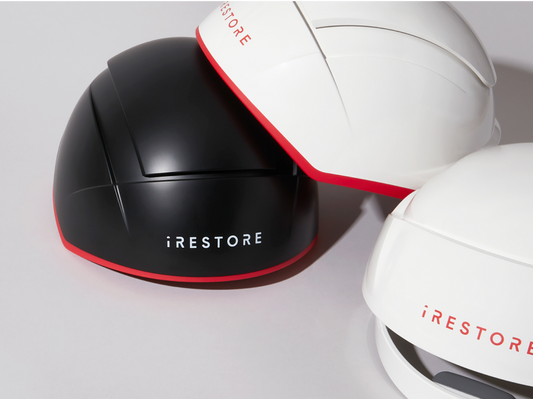
Reach Your Hair Growth Goals
Find out if iRESTORE can help you reverse your hair loss and restore your confidence. Take the quiz now to get personalized recommendations.
Best Wavelength for Red Light Therapy for Hair Growth (650nm vs 850nm Explained)
Red light therapy has emerged as a revolutionary, non-invasive solution for hair restoration, offering hope to millions experiencing hair loss. With FDA-cleared technology now available, understanding which wavelength delivers the best results for your specific needs becomes crucial. The two most studied wavelengths are 650nm and 850nm, each offer unique benefits for stimulating hair growth, but choosing the right one depends on your hair loss stage and treatment goals. This comprehensive guide explores the science behind each wavelength, helping you make an informed decision for your hair restoration journey. Backed by clinical studies showing measurable results, red light therapy provides a drug-free alternative that naturally stimulates your hair follicles back to life. What is Red Light Therapy for Hair Growth? Red light therapy (RLT), also known as low-level laser therapy (LLLT), is a non-surgical, FDA-cleared treatment that stimulates dormant hair follicles using specific wavelengths of light. It enhances blood circulation to the scalp, delivering essential nutrients to hair follicles and boosting cellular energy, which revitalizes weakened hair roots. For more on how red light therapy helps with hair restoration, check out our article on Does Red Light Therapy Help with Scars?. RLT activates the anagen (growth) phase of the hair cycle, promoting thicker, healthier hair. Clinical studies show an average hair density increase of 43.2%, with 100% of participants experiencing hair growth. This drug-free treatment is safe, gentle, and effective, making it a proven solution for both early thinning and more advanced hair loss. How Does Red Light Therapy Stimulate Hair Growth? Red light therapy stimulates hair growth by energizing hair follicles through photobiomodulation. Specific wavelengths of light increase ATP production in follicle cells, reviving dormant follicles and promoting active hair growth. Improved circulation also plays a key role, as the light dilates blood vessels, boosting nutrient and oxygen delivery to hair roots, while removing waste products that can hinder follicle function. Additionally, RLT reduces inflammation, which is often linked to hair loss. This process extends the anagen (growth) phase, leading to thicker, healthier hair. Consistent treatment results in improved hair density, shaft diameter, and overall scalp health. RLT provides gentle, non-invasive stimulation, making it an ideal long-term solution for healthy hair growth. Understanding Red Light Wavelengths (650nm vs 850nm) 650nm (Red Light) The 650nm wavelength produces visible red light that penetrates 1-2 millimeters into the scalp, effectively stimulating follicles in the upper dermal layers. To learn more about how red light therapy benefits different types of hair loss, refer to How Much Hair Loss is Normal and When to Worry. It targets follicular keratinocytes and dermal papilla cells, key for hair growth. This wavelength is ideal for early-stage hair thinning or preventive treatment, helping to activate miniaturized follicles and prevent further hair loss. Clinical studies show that 650nm therapy increases hair count and hair shaft diameter, with optimal results after 12-16 weeks of daily 25-30 minute sessions. 850nm (Near-Infrared Light) The 850nm wavelength penetrates 3-4 millimeters deeper into the scalp, reaching dormant or deeply miniaturized follicles. This deeper penetration stimulates mitochondrial activity, promoting hair growth in areas where surface treatments are ineffective. It is especially beneficial for advanced hair loss, reactivating stubborn follicles that haven't responded to other treatments. Research shows that 850nm light can reactivate previously dormant follicles, offering hope for those with significant thinning or bald spots. Key Differences Between 650nm and 850nm for Hair Growth Penetration Depth The key difference between the 650nm and 850nm wavelengths is their depth of penetration. For further insight on the differences between these wavelengths, explore The Difference Between Laser and LED for Hair Growth. 650nm red light offers surface-level stimulation, focusing on follicles in the upper scalp layers, making it ideal for recently affected or mild thinning areas. On the other hand, 850nm near-infrared light penetrates 3-4 millimeters deeper into the scalp, targeting follicles that have migrated deeper due to miniaturization. This depth difference impacts treatment effectiveness at different stages of hair loss. 650nm is great for prevention and early intervention, while 850nm becomes crucial for treating more advanced hair loss with deep follicular miniaturization. Effectiveness in Different Stages of Hair Loss For mild hair thinning, 650nm is most effective by preventing further miniaturization and encouraging thicker growth from weakening follicles. It helps maintain existing hair density and stimulates growth in early-stage hair loss. Using 650nm early on can prevent progression to more advanced hair loss. In contrast, 850nm is better for advanced hair thinning and rejuvenating deeply miniaturized follicles. Its deeper penetration allows it to reach follicles that haven’t responded to surface-level treatments, making it ideal for individuals with long-standing hair loss or significant balding areas. 850nm has been shown to reactivate follicles that were previously dormant for months or even years. Treatment Duration and Intensity Treatment protocols vary due to the difference in penetration. 650nm typically requires 20-30 minute daily sessions for optimal results, as surface-level stimulation needs frequent treatment to maintain follicular activity. On the other hand, 850nm may allow for more flexible treatment schedules due to its deeper, longer-lasting effects. Sessions usually last 15-25 minutes, and once initial results are seen, treatment frequency can be reduced to every other day. The deeper tissue effects provide sustained benefits, making it possible to extend the time between sessions while maintaining effectiveness. Research Supporting 650nm vs 850nm for Hair Growth Clinical research supports the effectiveness of both 650nm and 850nm wavelengths for hair restoration, each offering distinct benefits. A study in the American Journal of Clinical Dermatology found that 650nm therapy increased hair density by 37% over 16 weeks, with significant improvements in hair count, shaft thickness, and scalp coverage. 850nm near-infrared therapy has shown impressive results for advanced hair loss, with clinical trials revealing that 68% of participants with androgenetic alopecia experienced reactivation of dormant follicles. This wavelength's deeper penetration effectively treats follicles unresponsive to surface-level therapies, offering hope for individuals with established balding. Comparative studies show 650nm excels in preventing early-stage hair loss progression, while 850nm is more effective at reversing follicle miniaturization. Combined therapy using both wavelengths has resulted in up to a 51% improvement in hair density, demonstrating the benefits of personalized treatment based on hair loss severity and duration. Recommendations for Effective Use of Red Light Therapy To maximize results, follow the treatment protocols for your chosen wavelength. For 650nm therapy, use the device for 25-30 minutes daily, positioning it 6-12 inches from your scalp. For 850nm, start with 15-25 minute daily sessions for 12 weeks, then reduce to every-other-day maintenance. Ensure full scalp coverage and clean your scalp before each session. Combine therapy with a healthy hair care routine. Use sulfate-free shampoos, avoid heat styling, and maintain a diet rich in protein, vitamins, and minerals. Stay hydrated, manage stress, and track progress with consistent photos over 12-16 weeks. Choosing the Right Wavelength and Device for Your Hair Growth Needs For Early-Stage Hair Thinning: If you're noticing early signs of thinning or have a family history of hair loss, 650nm is the ideal wavelength. It stimulates follicles just beginning to miniaturize, preventing further deterioration and encouraging thicker growth. For Advanced Hair Loss: 850nm near-infrared therapy is best for those with established balding or significant thinning. Its deeper penetration reactivates follicles that surface treatments can’t reach, offering the best chance for regrowth in more advanced stages. How to Assess Your Hair Loss Stage: Early-stage loss typically involves thinning with maintained coverage, while advanced loss shows visible scalp and reduced density. The duration of hair loss can help indicate the appropriate wavelength—recent loss suggests early-stage, while long-term loss calls for deeper treatment. Choosing the Right Device: Select devices based on coverage area, power output, and wavelength specifications. Laser caps offer hands-free convenience, while handheld devices provide targeted treatment. Ensure the device is FDA-cleared, with sufficient power density and verified wavelength accuracy, and fits comfortably into your routine. CHOOSE THE RIGHT DEVICE Conclusion The choice between 650nm and 850nm wavelengths depends on your hair loss stage. 650nm is ideal for early-stage thinning, stimulating follicles and preventing further miniaturization. For advanced hair loss, 850nm provides deeper penetration to reactivate dormant follicles. With FDA-cleared red light therapy, like the iRESTORE Hair Growth System, you can restore hair fullness without drugs. See visible results in as little as three months by choosing the right wavelength and maintaining consistent treatment. Stay dedicated to your routine with iRESTORE for thicker, healthier hair and renewed confidence. Experience the benefits of scientifically-backed, non-invasive hair restoration today. FAQs Which red light wavelength is best for early-stage hair thinning? For early-stage thinning, 650nm is most effective. It stimulates follicles that are just beginning to miniaturize, preventing further hair loss and promoting thicker growth. Which red light wavelength is best for advanced hair loss? For advanced hair loss, 850nm is ideal as it penetrates deeper into the scalp and can reactivate dormant follicles that surface-level treatments can't reach. Can I use both 650nm and 850nm wavelengths together? Yes, combining 650nm and 850nm therapies has shown synergistic effects, resulting in up to a 51% improvement in hair density, especially in cases where both early-stage and advanced hair loss are present. Disclaimer: The iRESTORE blog is for informational purposes only and is not intended to replace professional medical advice or treatment. Please do not ignore professional guidance because of information you’ve read here. If you have concerns about your hair or skin health, we encourage you to consult a qualified healthcare professional.
Read MoreBryan Johnson's Daily Longevity Routine with Red Light Therapy
Bryan Johnson is well-known for his dedicated efforts to extend his lifespan. His daily routine is highly structured, including a strong emphasis on dermatological health. He particularly focuses on preventing hair loss and enhancing skin rejuvenation through consistent use of various red light therapies. Bryan Johnson's Red Light Therapy for Hair Loss & Hair Growth Bryan Johnson utilizes red light therapy (RLT) devices daily as part of his strategy to combat hair loss and encourage new hair growth. The central idea is to shine targeted red and near-infrared light onto the scalp. Red Light Therapy works by penetrating the skin to stimulate cellular activity within the hair follicles. This process is believed to: Re-energize dormant or miniaturizing hair follicles. Improve blood flow to the scalp, ensuring follicles receive vital nutrients and oxygen. Reduce inflammation, which is often a key factor in hair loss. iRESTORE red light therapy devices for hair loss and hair regrowth are considered top products due to their FDA clearance, extensive clinical studies demonstrating efficacy, and a high concentration of medical-grade lasers and LEDs, more scalp coverage, ensuring effective and safe treatment for hair loss. iRESTORE Laser Helmets What’s the difference between iRESTORE vs Laser Cap Brands? The iRESTORE laser helmets are highly regarded in the hair growth market due to a combination of high diode count, extended coverage, and favorable guarantees. Unlike many competitors that rely exclusively on either lasers or LEDs, iRESTORE employs a hybrid system that uses both powerful laser diodes (for deep, targeted follicular stimulation) and LEDs (for wide area coverage and overall scalp health), with top models like the Elite featuring up to 500 total diodes. Furthermore, the helmet design ensures maximum scalp coverage, specifically targeting the temples, hairline, and full crown, areas that can be missed by standard cap designs. Red Light Therapy for Facial Rejuvenation Bryan Johnson also utilizes red light therapy to address skin concerns, including collagen production, fine lines, and overall skin tone. The consistent exposure to red light helps stimulate cellular repair and regeneration in the skin. The iRESTORE Illumina LED Face Mask is a dermatologist-recommended, medical-grade LED device that is marketed as a comprehensive, at-home solution for multiple major skin concerns simultaneously. It is notable for being one of the first home-use masks to incorporate three distinct wavelengths. Users can expect to see visible results in as little as 6 weeks by committing to 10-minute sessions, 3 to 5 times per week. The iRESTORE Illumina LED Face Mask stands out due to its triple wavelength LED technology, ergonomic design for optimal skin contact, and proven ability to address various signs of aging, making it a leading choice in its category. While direct competitor comparisons for every product are vast, the iRESTORE Illumina series generally distinguishes itself through: Medical-Grade Lasers and LEDs: iRESTORE often uses a higher concentration and quality of light-emitting components, which can lead to more potent and consistent results compared to devices with fewer or lower-grade lights. Targeted Design: Each iRESTORE Illumina product is specifically engineered for its intended use (face and eyes), optimizing the light delivery and wavelengths for those particular concerns. Clinical Studies and Research: iRESTORE frequently references research and studies to support its claims, offering users more confidence in the product's effectiveness. Ergonomics and User Experience: The design of iRESTORE products, such as the face mask's ergonomic fit, aims to ensure optimal skin contact and ease of use for consistent daily application. The iRESTORE Illumina LED Eye Mask is a specialized light therapy device designed to rejuvenate the delicate skin around the eyes by utilizing targeted wavelengths of light. The primary purpose of the iRESTORE Illumina LED Eye Mask is to target the five major signs of aging in the eye area; fine lines and wrinkles, loss of firmness/elasticity under the eyes, dark circles and pigmentation, eye hollows and under-eye bags. The mask works by using 180 medical-grade LEDs that deliver dual wavelengths (Red Light at 633nm and Near-Infrared Light at 830nm) to the skin. The iRESTORE Illumina LED Eye Mask is considered a top product due to its focused design for the sensitive eye area, precise wavelength delivery, and ability to effectively combat common periorbital concerns without discomfort. Delivers leading LED coverage and achieves superior results. Bryan Johnson's unwavering commitment to both advanced light therapies and a carefully selected array of topical products underscores his comprehensive approach to maintaining and enhancing his physical vitality, demonstrating a belief that consistency and scientific backing are paramount for achieving significant longevity outcomes.
Read MoreHow Does Red Light Therapy Help with Scars?
Scars are a natural part of the healing process, but they can often leave behind visible marks that affect both skin texture and confidence. Traditional treatments like invasive procedures, chemical creams, or surgeries may feel intimidating and carry risks such as irritation or downtime. For those looking for a gentler, non-invasive solution, red light therapy has gained attention as a safe and effective option to support the body’s natural repair processes. Red light therapy uses specific wavelengths of visible red and near-infrared light that penetrate the skin at different depths. They energize your cells’ mitochondria, which kickstarts repair and healing. This boost in cellular activity enhances blood flow, encourages collagen production, and reduces inflammation. Together, these effects create an ideal environment for tissue repair, making red light therapy a promising solution for improving the appearance of scars. How Red Light Therapy Helps with Scars Red light therapy supports scar healing in multiple ways, making it one of the most versatile non-invasive options available today. 1. Helps Scars Blend in BetterCollagen strengthens and rebuilds skin structure, while elastin improves flexibility and smoothness. With regular red light exposure, scar tissue gradually softens and blends more naturally with the surrounding skin. 2. Improves circulationBy enhancing blood flow, red light therapy helps deliver oxygen and nutrients more efficiently to damaged areas. It also aids in removing waste products, which accelerates tissue repair and recovery. 3. Reduces inflammationInflammation often contributes to redness, swelling, and discomfort around scars. Red light calms irritated skin, creating a healthier environment for long-term regeneration. Different scar types can respond positively to these benefits. Acne scars may look less indented, surgical scars can become smoother, and injury-related scars may fade in appearance. While newer scars generally respond faster, even older scars can improve with consistent treatment. Choosing the Right Red Light Therapy Device With the growing popularity of light-based treatments, there are now both professional and at-home red light therapy options available. Professional devices: Found in dermatology or wellness clinics, they often deliver higher intensity treatments but require repeated visits that can be costly over time. At-home devices: Designed for convenience, these provide therapeutic wavelengths that make it easier to maintain consistent treatments without leaving home. When evaluating devices, consider: Wavelengths between 630 and 850 nm for optimal skin benefits. Treatment coverage that suits your target area. Ease of use, ensuring you can comfortably integrate sessions into your routine. Consistency is the key factor in seeing results, so choosing a device that supports regular use is essential. How Red Light Therapy Works with iRESTORE iRESTORE is widely recognized for its expertise in light-based wellness technology. While the brand is best known for its hair growth systems, the same science behind its devices targets red light wavelengths that promote cellular energy and circulation, supporting broader skin health benefits, including scar care. Loved by over 500K customers worldwide, iRESTORE offers safe, effective, and easy-to-use light therapy devices for home use, making it simple to enjoy the benefits of red light therapy without depending on costly in-office treatments. How to Use Red Light Therapy for Best Results The effectiveness of red light therapy for scars depends heavily on consistent use. At-home devices make it easy to build treatment into your wellness or skincare routine. Prepare your skin: Begin with clean, dry skin for maximum light absorption. Follow device guidelines: Position the device 6–12 inches away for even coverage. Sessions usually last 10–20 minutes. Set a routine: Aim for 3–5 sessions per week. Sticking to the same time each day, such as during your skincare routine, can help maintain consistency. Support with skincare: Apply a gentle, fragrance-free moisturizer afterward to lock in hydration. Track progress: Taking progress photos every few weeks helps you notice subtle but steady improvements. Over time, these habits allow red light therapy to gradually soften scars, reduce discoloration, and improve overall skin smoothness. Safety Tips and Things to Know Red light therapy is non-invasive and generally well-tolerated, with minimal risk of side effects. Most users experience only a mild warming sensation during treatment. Unlike chemical peels or laser resurfacing, it doesn’t damage the skin or require recovery time. However, results vary based on scar type, age, and overall skin health. People taking photosensitive medications or with certain medical conditions should consult a healthcare provider before beginning treatment. For deeper surgical or long-standing scars, seeking input from a dermatologist can ensure the best results. Reducing Scars with Red Light Therapy Red light therapy is an effective, science-backed approach for improving the look and feel of scars. By stimulating collagen, increasing circulation, and reducing inflammation, it promotes the skin’s natural healing process without the risks of more invasive procedures. With the availability of safe and convenient at-home devices, it’s easier than ever to make red light therapy part of your daily routine. For those looking to reduce scar visibility while supporting overall skin health, this treatment offers a practical and confidence-boosting solution. Confidence Restored! FAQs 1. How long does it take for red light therapy to improve scars?Most people start noticing subtle changes in skin texture and tone after 4–6 weeks of consistent use. More visible improvements in scar appearance may take 8–12 weeks or longer, depending on the scar type and age. 2. Can red light therapy remove scars completely?Red light therapy cannot erase scars entirely, but it can significantly reduce their visibility. Over time, scars may appear smoother, lighter in color, and less noticeable against the surrounding skin. 3. Is red light therapy safe for all skin types?Yes, red light therapy is considered safe for all skin types and tones. Since it does not use UV light or harsh chemicals, it does not increase the risk of burns or pigmentation changes when used correctly. 4. Does red light therapy work better on new scars or old scars?Newer scars generally respond more quickly since the healing process is still active. However, older scars can also improve with consistent treatments, though it may take more time to see noticeable changes. 5. Can I combine red light therapy with other scar treatments?Yes. Many people pair red light therapy with moisturizers, silicone gels, or dermatologist-recommended treatments. Always consult a professional if you plan to combine it with more aggressive procedures like microneedling or chemical peels. Disclaimer: The iRESTORE blog is for informational purposes only and is not intended to replace professional medical advice or treatment. Please do not ignore professional guidance because of information you’ve read here. If you have concerns about your hair or skin health, we encourage you to consult a qualified healthcare professional.
Read MoreThe Best Eye Bag Treatments
Eye bags can be caused by fluid retention, thin skin, shifting fat pads, allergies, salt intake, and sleep habits. The best approach mixes smart daily care with targeted treatments. Below, we compare popular under eye bag treatments—including red light therapy under eyes with the Illumina LED Eye Mask—so you can choose confidently. What Causes Eye Bags? “Eye bags” usually reflect a mix of factors: temporary fluid buildup, thinning skin that reveals shadows, and in some cases fat pads shifting forward with age. Your plan should match the driver—surface puffiness vs. structural changes. Quick tip: Improve sleep consistency, manage salt/alcohol, use daily SPF, and stay gentle with the under-eye area. These habits make every treatment more effective. How Red Light Therapy Supports the Under-Eye Area Eye red light therapy uses specific wavelengths that are absorbed by skin cells, encouraging cellular activity and collagen support. For many, this leads to a firmer, smoother look over time—especially where thin, crepey skin exaggerates puffiness and shadows. It’s non-invasive, drug-free, and designed for consistent at-home use. Pros: Why a Red Light Therapy Eye Mask is a Top Choice Skin quality support: Encourages collagen activity to improve the look of thin, crepey skin. Non-invasive & drug-free: No needles, downtime, or prescriptions. Consistency made easy: Hands-free sessions that slot into your routine. Pairs with skincare: Complements retinol, peptides, and hydration (alternate nights if sensitive). Even coverage: Mask design treats both under-eye and crow’s-feet zones uniformly. Cons (What to Expect) Gradual results: Best with steady use over weeks. Habits still matter: Poor sleep and high salt can diminish progress. Not for severe fat-pad prolapse: Advanced eye bags may need in-office options. Illumina Eye Mask vs. Other Under-Eye Treatments The Illumina LED Eye Mask is our recommended baseline for ongoing maintenance. Here’s how it stacks up against other options for how to remove eye bags and keep them in check. Comparing the best eye bag treatment options Treatment What it targets Pros Cons Best for iRESTORE Illumina Eye Mask Skin quality (collagen), mild puffiness, crepey texture Non-invasive; at-home; easy to stay consistent; complements skincare Results build gradually; requires routine; not a surgical replacement Daily self-care and long-term maintenance Eye creams (caffeine, peptides, retinol) Fluid retention, fine lines, hydration Simple; travel-friendly; budget-flexible Surface-level; must use daily; potency varies widely Maintenance and pairing with devices Cold tools / patches Morning puffiness (fluid) Immediate depuff; inexpensive Temporary; no structural change Quick fixes and travel In-office filler Tear-trough hollowing (shadowing) Fast improvement in volume Cost; expert skill required; not for true puffiness Deep hollows without significant bags Energy devices (RF, microneedling, lasers) Skin laxity and texture Stronger collagen remodeling Downtime and higher cost; strict sun care Moderate laxity + texture concerns Lower blepharoplasty (surgery) Fat-pad prolapse, severe bags Definitive anatomic correction Surgery and recovery; highest cost Pronounced, persistent bags Why Many Start with the Illumina LED Eye Mask Hands-free routine: Easy to stick with several nights per week. Comfortable, even coverage: Targets under-eye and crow’s-feet together. Layer-friendly: Use on clean, dry skin; follow with gentle hydration. Non-invasive first step: Ideal before considering procedures. A Simple Week-One Plan for Eye Bags Morning: Cool compress 3–5 minutes, then caffeine/peptide eye cream. Evening (3–5x/week): Illumina session on clean, dry skin; moisturize after. Always: Daily SPF, consistent sleep, manage allergies, moderate late-night salt. FAQ: Red Light Therapy Eye Bags Is red light therapy safe around the eyes? Use devices as directed and avoid staring directly into LEDs. If you have eye conditions or photosensitivity, consult your clinician first. How long until I notice changes? Most people see gradual improvements with steady use over several weeks, supported by healthy sleep and daily SPF. Can I combine Illumina with retinol or acids? Yes—alternate nights if your skin is sensitive. Keep actives away from the immediate lash line and follow with hydration. Shop the Illumina LED Eye Mask under eye bag treatments, red light therapy under eyes, how to remove eye bags, eye red light therapy, red light therapy eye bags, best eye bag treatment
Read MoreAre Red Light Therapy Face Masks Safe for Your Eyes?
Yes, red light therapy face masks are safe for your eyes when used as directed. Red light therapy face masks have become one of the most popular tools in modern skincare routines. Once limited to professional treatments, they’re now widely available for at-home use, giving people a convenient way to target concerns like fine lines, dullness, and uneven skin tone. The soft red glow may look futuristic, but its promise of rejuvenated skin has made these masks a go-to option for anyone looking to upgrade their daily self-care.With that rise in popularity, an important question often comes up: Are red light therapy masks safe for your eyes? It’s a valid concern. Our eyes are sensitive, and the idea of bright LEDs positioned close to the face can naturally cause hesitation. Some wonder about eye strain, while others worry about potential long-term effects. How Red Light Therapy Works Red light therapy works by using gentle red and near-infrared light that is safe for the skin. Unlike UV rays from the sun, which can be harmful, this type of light is non-invasive and soothing. It does not burn or damage the skin. Instead, it works with the body in a supportive way. When the light reaches the skin, it travels into the deeper layers where it helps boost the skin’s natural repair process. This stimulation encourages the production of collagen, improves circulation, and supports healthier-looking skin overall. Over time, it can help soften fine lines, brighten a dull complexion, and create a smoother, more radiant texture. Red light therapy face masks are designed to spread this glow evenly across the skin. Because the light is gentle and carefully controlled, it’s safe for regular at-home use and doesn’t require recovery time like harsher treatments. With consistent use, many people notice their skin looks fresher, healthier, and more revitalized. Benefits of Red Light Therapy Face Masks One of the biggest reasons red light therapy masks have become so popular is the visible impact they can have on skin health and appearance. Consistent use can lead to a range of improvements that many people notice within just a few weeks. Collagen Support for Firmer SkinRed light stimulates the natural production of collagen, the protein that keeps skin firm and youthful. With time, this can soften the look of fine lines and wrinkles. Brighter, More Even Complexion By improving circulation, red light helps bring more oxygen and nutrients to the skin. The result is a complexion that looks fresher, brighter, and more even in tone. Smoother, Healthier-Looking Texture Regular sessions can help reduce roughness and give the skin a more refined, radiant surface, while also minimizing the tired, dull look caused by daily stress. Beyond the visible results, red light therapy masks also offer convenience. Instead of scheduling expensive spa treatments, users can enjoy the same technology at home. The ease of use makes it simple to stay consistent, which is key to seeing long-term results. Eye Safety with Red Light Therapy Masks With a mask that sits so close to your face, it’s natural to pause and ask whether the light might affect your eyes. Many people wonder if the brightness could cause strain or even long-term issues. These concerns usually come from comparing red LEDs to harsher light sources like UV rays or medical lasers, which are known to cause damage. The reality is different. Red and near-infrared light used in therapy masks is low-level, non-invasive, and generally considered safe when used properly. Unlike UV, it doesn’t damage tissue or increase risks linked to sun exposure. Instead, the light is carefully calibrated to target the skin’s surface and deeper layers for rejuvenation, without harming surrounding areas. That said, the same advice applies here as with any light-based device: don’t stare directly into the bulbs. For some people, especially those who are sensitive to brightness, prolonged eye exposure can feel uncomfortable. Closing your eyes during a session or wearing protective eyewear are simple ways to enhance comfort. Well-designed masks are built with this in mind, limiting unnecessary direct exposure to the eyes while still delivering results. By choosing a trusted device and following usage guidelines, users can enjoy the skin benefits of red light therapy while knowing their eye health is being looked after. iRESTORE’s Thoughtful Approach to Eye Comfort and Skin Health The iRESTORE Face Mask has been carefully designed to combine skincare benefits with user comfort and safety. Using controlled red LED light at gentle wavelengths, the mask delivers even coverage across the skin while avoiding unnecessary strain on the eyes. Unlike stronger medical-grade lights, the LEDs in the mask are calibrated for safe, at-home use. The mask’s structure naturally shields the eye area, allowing users to relax during each session without feeling overwhelmed by brightness. For added comfort, it can also be used with the eyes closed. Those who are especially sensitive to light may choose to wear protective eyewear, although for most people it isn’t necessary. Every iRESTORE Face Mask comes with clear usage guidelines, including recommended session times and steps to maximize results. Following these instructions ensures that the therapy remains safe in the long term. By combining thoughtful design with straightforward guidance, iRESTORE makes red light therapy accessible to anyone looking to enhance their skincare routine at home. The focus is simple: deliver real skin benefits while keeping the experience safe, comfortable, and easy to use. Hear It from Our Customers Safe for Eyes, Healthy for Skin Red light therapy face masks have transformed the way people approach skincare at home. They make it possible to enjoy the same type of light technology once reserved for professional settings, now with the convenience of daily use. While concerns about eye safety are common, the evidence shows that when these masks are used as directed, they are safe, comfortable. The benefits go far beyond safety, from supporting collagen and improving texture to brightening the complexion and reducing signs of fatigue. With consistent use, results build naturally over time and leave the skin looking healthier and more radiant. Designed with user comfort in mind and trusted by over 500,000 customers worldwide, the iRESTORE Face Mask makes it simple to enjoy these results at home. With iRESTORE, it is not just better skin, Confidence Restored! FAQs Are red light therapy face masks safe for the eyes?Yes, red light therapy masks use gentle red and near-infrared light that is non-invasive and safe when used properly. They do not emit harmful UV rays, but it is recommended to avoid staring directly into the bulbs during use. Do I need to wear protective eyewear while using a red light therapy mask? Protective eyewear is optional. Most masks, including the iRESTORE Face Mask, are designed to minimize direct exposure to the eyes. Simply closing your eyes during a session is usually enough for comfort. How does red light therapy benefit the skin? Red light therapy helps boost collagen production, improve circulation, brighten skin tone, and smooth texture. With consistent use, it supports healthier, firmer, and more radiant-looking skin. Can I use a red light therapy mask every day? Yes, many at-home masks are designed for regular use. iRESTORE provides clear usage guidelines with recommended session times to help you stay consistent and maximize results safely. What makes the iRESTORE Face Mask different from other devices?The iRESTORE Face Mask is built with user safety and comfort in mind. It uses carefully calibrated red LED light, offers even skin coverage, and naturally shields the eye area. It also comes with clear instructions to ensure safe and effective use. Disclaimer: The iRESTORE blog is for informational purposes only and is not intended to replace professional medical advice or treatment. Please do not ignore professional guidance because of information you’ve read here. If you have concerns about your hair or skin health, we encourage you to consult a qualified healthcare professional.
Read MoreLED Light Therapy for Rosacea: Proven Benefits, Real Results, and Why It Works
Rosacea can feel like a constant battle, from the morning flush in the mirror to the sting of stepping outside on a sunny day. For millions of people, this chronic skin condition isn’t just about appearance; it’s about comfort, confidence, and quality of life. Advances in non-invasive skincare technology mean there are now safe, clinically proven ways to calm redness, soothe irritation, and support healthier skin from within. LED light therapy has emerged as one of the most promising options backed by research, trusted by dermatologists, and gentle enough for sensitive skin.In this guide, we’ll explore how LED light therapy works for rosacea, the science behind its results, and practical ways you can use it to take control of your skin health. Rosacea: Causes, Symptoms, and Triggers Rosacea is a chronic skin condition that goes beyond occasional flushing; it’s a persistent issue that can cause visible redness, visible blood vessels, and even acne-like bumps. Rosacea develops gradually and may worsen without proper management. Its exact cause is still unknown, but experts believe it’s linked to a combination of genetics, immune system response, and environmental factors. Understanding its symptoms, causes, and common triggers is the first step toward finding the right treatment.. Rosacea presents in several subtypes: Erythematotelangiectatic Rosacea – Persistent redness, flushing, and visible blood vessels. Papulopustular Rosacea – Redness combined with acne-like bumps or pustules. Phymatous Rosacea – Thickened skin texture, often around the nose. Ocular Rosacea – Redness, burning, or irritation affecting the eyes. While rosacea’s exact cause remains unclear, we know it’s influenced by a combination of genetics, immune response, and environmental triggers. Common triggers for flare-ups include: Sun exposure Hot beverages or spicy foods Alcohol Stress Extreme temperatures Beyond the physical effects, rosacea can have a real emotional impact. Many sufferers report reduced confidence, social discomfort, and even anxiety during flare-ups. The good news is that with the right treatment approach, like LED light therapy, you can manage symptoms effectively, reduce flare frequency, and restore both skin comfort and self-confidence. What Is LED Light Therapy and How Does It Work for Rosacea LED light therapy is a gentle and non-invasive skincare treatment that uses specific wavelengths of light to improve skin health at a cellular level. For rosacea, two wavelengths have shown the most proven effectiveness. Red Light (630 to 660nm) helps target surface inflammation, reduce redness, and support collagen production to strengthen the skin barrier.Near-Infrared Light (810 to 850nm) penetrates deeper into the skin to boost circulation, speed up tissue repair, and energize skin cells for faster recovery. When these wavelengths reach the skin, they are absorbed by the cells’ mitochondria, often referred to as the power plants of the cell. This process triggers increased production of adenosine triphosphate, also known as ATP, which is the energy source that fuels cell repair and renewal. For people with rosacea, this process means calmer and less inflamed skin, stronger resistance to everyday triggers such as heat or wind, and a smoother, healthier-looking complexion over time. Unlike topical creams or oral medications that may cause irritation, LED light therapy works in harmony with your skin’s natural processes. It is safe for sensitive skin, suitable for long-term use, painless, and requires no downtime. Treatments can be done in the comfort of your home or a professional setting. Benefits of LED Light Therapy for Rosacea LED light therapy provides more than just surface-level improvements. It addresses the underlying causes of redness and discomfort, helping you achieve lasting results. Reduce Persistent Redness By calming overactive blood vessels and controlling inflammation, LED therapy visibly fades facial redness even during flare-ups. Soothe Irritation and Sensitivity The gentle wavelengths help regulate the skin’s immune response, reducing the burning, stinging, and tenderness often experienced with rosacea. Strengthen the Skin Barrier LED therapy boosts collagen and elastin production, which helps fortify the skin against environmental triggers such as sun, wind, and temperature changes. Improve Skin Texture and Tone With healthier skin cells and improved circulation, the skin appears smoother, more even, and less blotchy over time. Enhance Confidence and Comfort Calmer skin and fewer flare-ups make it easier to go about your day without worrying about sudden redness. Clinical Evidence and Real-World Results of LED Therapy for Rosacea How to Use LED Light Therapy for Rosacea at Home At iRESTORE, we believe every step in your treatment should be simple, comfortable, and backed by science. Here’s how to get the most from your LED light therapy sessions, so you can see visible changes in redness and feel confident about your skin again. Step 1: Prepare Your Skin – Give Your Skin a Fresh Start Gently cleanse with a mild, rosacea-safe cleanser to remove makeup, sunscreen, and impurities. Pat dry with a soft towel; avoid rubbing to prevent irritation. Keep your skin product-free before treatment. This allows the therapeutic light to penetrate without barriers. Step 2: Set Up Your Device – Choose the Right Light for Results Select the red light + near-infrared light mode, clinically shown to reduce inflammation, improve circulation, and energize skin cells. Position your device so it fully covers the treatment area. With masks or panels, ensure a comfortable fit for even light exposure. Step 3: Begin Your Treatment – Just 10 Minutes Relax and let the light do the work. There’s no heat, no pain, and no downtime. Use 3–4 times per week to maintain steady progress. Each session helps calm redness, repair skin tissue, and strengthen your skin barrier. Step 4: Post-Treatment Care – Lock In the Benefits Apply a lightweight, fragrance-free moisturizer to support hydration. If your session is during the day, follow with a broad-spectrum SPF; rosacea-prone skin needs consistent sun protection. Step 5: Stay Consistent – Your Skin Will Thank You Most users notice visible improvements in 4–6 weeks of regular use. Take weekly photos to track changes in redness and texture. Combine with a gentle skincare routine and trigger management for lasting results. With just a few sessions each week, you can take control of your rosacea care from the comfort of home. Try iRESTORE LED devices today, trusted by 500K+ customers and backed by science. Safety, Side Effects, and Precautions for LED Light Therapy At iRESTORE, your safety and confidence always come first. LED light therapy is one of the gentlest, most skin-friendly treatments for rosacea, but understanding what to expect helps you use it with peace of mind. Possible Mild Side Effects: Some users may notice temporary, harmless effects during the first few sessions, such as: Mild redness or warmth in treated areas Slight tingling sensation as skin cells respond to the light These sensations typically fade within minutes to a few hours and are a normal part of the skin’s adjustment process. When to Consult a Professional First We recommend speaking with a dermatologist before starting LED therapy if you: Have open wounds, active skin infections, or severe inflammation Take photosensitizing medications (some antibiotics, acne treatments, or herbal supplements) Have a history of skin cancer or are undergoing treatment for it Are you pregnant or breastfeeding (for extra caution) Tips for Safe, Consistent Use Follow your device’s instructions for session length and frequency — overuse won’t speed results and may cause unnecessary irritation. Keep your device clean and store it in a dry, safe place. Always pair LED therapy with gentle skincare and daily sun protection for the best outcomes. iRESTORE Reassurance: LED light therapy is designed to work with your skin, not against it. By following safe-use guidelines and listening to your skin’s needs, you can enjoy visible improvements without downtime, discomfort, or harsh side effects. Making LED Light Therapy Part of a Complete Rosacea Management Plan LED light therapy can be a game-changer for managing rosacea, but the best results come when it’s part of a complete, skin-friendly lifestyle. By combining consistent treatment with healthy habits, you give your skin the best chance to stay calm, resilient, and flare-free. 1. Protect Your Skin from Triggers Sun protection is essential wear a broad-spectrum SPF daily, even indoors near windows. Minimize exposure to extreme temperatures and wind whenever possible. Keep a trigger diary to spot patterns with food, stress, or environmental changes. 2. Support Skin Barrier Health Use gentle, fragrance-free skincare products. Avoid harsh scrubs or strong chemical exfoliants that can aggravate redness. Moisturize regularly to keep skin hydrated and protected. 3. Maintain a Balanced Diet & Lifestyle Limit alcohol, spicy foods, and very hot drinks if they trigger flare-ups. Eat anti-inflammatory foods like berries, leafy greens, and omega-3-rich fish or plant sources. Manage stress with relaxation techniques such as yoga, meditation, or deep breathing. 4. Stay Consistent with LED Therapy Make sessions part of your weekly routine because results build over time. Track improvements with photos to stay motivated. Pair LED therapy with any dermatologist-recommended topical or oral treatments for a well-rounded approach. Calmer Skin and Renewed Confidence with LED Therapy Living with rosacea can feel like a constant balancing act, avoiding triggers, managing flare-ups, and searching for solutions that work. LED light therapy offers a new path forward: a safe, gentle, and clinically backed treatment that helps your skin heal from within. With consistent use, it can reduce redness, strengthen your skin’s natural defenses, and bring back the comfort and confidence you deserve. And when paired with healthy habits and trigger management, it becomes more than a treatment; it’s a long-term investment in your skin health. With iRESTORE, you’re not just managing rosacea you’re reclaiming comfort, control, and confidence in your skin. Confidence restored. Frequently Asked Questions About LED Light Therapy for Rosacea Is LED light therapy safe for rosacea-prone skin? Yes. LED light therapy is non-invasive, gentle, and safe for sensitive or rosacea-prone skin when used as directed. It does not use UV light, so there’s no risk of sun damage. How soon will I see results from LED light therapy?Most people notice visible improvements such as reduced redness and calmer skin within 4–6 weeks of consistent use, typically 3–4 sessions per week. Results may vary depending on your skin type and the severity of symptoms. Can I use LED light therapy with my other rosacea treatments?In most cases, yes. LED therapy works well alongside dermatologist-prescribed topical creams, oral medications, and gentle skincare products. Always check with your dermatologist before starting any new treatment combination. Does LED light therapy hurt or irritate?No. LED therapy is painless, with no heat, burning, or downtime. Some users may experience a mild warmth or slight tingling, which usually fades within minutes after the session. Will LED light therapy cure my rosacea?Rosacea currently has no cure, but LED light therapy can significantly reduce redness, calm irritation, and improve skin texture over time. Think of it as a long-term management tool rather than a one-time fix. Disclaimer: The iRESTORE blog is for informational purposes only and is not intended to replace professional medical advice or treatment. Please do not ignore professional guidance because of information you’ve read here. If you have concerns about your hair or skin health, we encourage you to consult a qualified healthcare professional.
Read MoreHow Red Light Therapy Helps Reduce Facial Scars and Improve Skin Health
Scars tell a story of healing, resilience, and the body’s remarkable ability to repair itself. For many, especially when they appear on the face, those marks can also be a daily reminder they would rather soften or fade. Advances in skin health technology now offer new ways to support that process, and one of the most promising is red light therapy. This non-invasive treatment is gaining recognition in dermatology clinics and at-home skincare routines. By using specific wavelengths of light to reach deep into the skin, it encourages natural repair processes that can improve texture, tone, and overall skin appearance, including the visibility of facial scars. The Science Behind Red Light Therapy Red light therapy works through a process called photobiomodulation, a gentle yet powerful approach to supporting your skin’s natural healing abilities. When specific wavelengths of light penetrate your facial skin, they are absorbed by the mitochondria the tiny “power plants” inside your cells. This boosts the production of adenosine triphosphate (ATP), the energy your cells need to repair, regenerate, and function at their best. Red light in the 630–660 nanometer range helps calm redness, reduce inflammation, and trigger collagen production, which is essential for smoother, more even skin texture. Near-infrared light, between 810–850 nanometers, travels deeper to improve blood circulation and encourage the growth of healthy tissue beneath the surface. Together, these wavelengths create an optimal environment for scar healing and overall facial skin rejuvenation. Types of Facial Scars That Benefit from Red Light Therapy Red light therapy can benefit multiple types of facial scars. Here’s how it works for each. Not all scars are the same, and understanding their type can help set realistic expectations for results. Whether your scars are recent or years old, red light therapy can play a role in softening their appearance and improving overall skin texture. Acne Scars (Atrophic Scars) These are small depressions or indentations in the skin caused by past breakouts. They form when inflammation damages collagen during the healing process. Red light therapy stimulates new collagen growth, helping to fill in these areas and create a smoother, more even complexion. Post-Surgical or Injury Scars Facial scars from stitches, cuts, or other procedures can sometimes appear raised, tight, or discolored. Consistent red light therapy can help reduce redness, improve flexibility in the skin, and encourage healthy tissue regeneration. Hypertrophic Scars These raised scars stay within the boundary of the original wound and can feel firm or itchy. By calming inflammation and regulating collagen production, red light therapy helps these scars gradually flatten and blend more naturally with surrounding skin. Pigmented or Discolored Scars Even when a scar is smooth, uneven pigmentation can make it stand out. Red light wavelengths help even out skin tone by supporting cellular turnover and reducing visible redness or blotchiness. By matching the treatment approach to the type of scar, red light therapy with iRESTORE can become an effective part of a consistent facial care routine, helping you achieve healthier and more radiant skin over time. Benefits of Red Light Therapy for Facial Scar Reduction Red light therapy does more than just reduce the visibility of scars, it works beneath the surface to improve your skin’s overall health and resilience. When used consistently, it can deliver a range of benefits that make it an essential part of a facial care routine. Stimulates Collagen and Elastin Production Collagen gives skin its structure, while elastin keeps it flexible. Red light wavelengths trigger your skin’s natural repair processes, encouraging the production of both. This helps fill in indented scars, soften rough texture, and improve firmness. Reduces Redness and Inflammation Fresh scars often appear red, pink, or irritated. By calming inflammation at the cellular level, red light therapy helps even out skin tone and reduces the flushed appearance of scar tissue. Improves Blood Flow for Faster Healing Increased circulation delivers more oxygen and nutrients to damaged areas. This supports quicker recovery, healthier tissue formation, and better long-term results. Softens and Smooths Skin Texture Whether your scars are raised or uneven, red light therapy promotes balanced collagen production, gradually making the skin’s surface feel softer and look more refined. Gentle, Non-Invasive, and Safe for Most Skin Types Unlike chemical peels, microneedling, or laser resurfacing, red light therapy does not damage the skin or require downtime. This makes it suitable for regular use at home with devices like the iRESTORE Illumina LED Face Mask. By targeting both the visible appearance and underlying health of the skin, red light therapy offers a multi-layered approach to facial scar care — one that works with your skin’s natural healing ability rather than against it. How to Use Red Light Therapy Safely for Facial Scars Red light therapy is gentle and effective, but following the right routine ensures you get visible results without irritation. With the iRESTORE, you can bring professional-quality treatment into your daily skincare routine safely and conveniently. Before You Begin Cleanse your skin to remove makeup, sunscreen, and excess oils so light can penetrate effectively. Avoid harsh products such as strong exfoliants, retinoids, or acids right before your session to prevent unnecessary sensitivity. During Your Session Use the right wavelengths. The Illumina LED Face Mask device delivers red light at 630–660 nm to calm inflammation and stimulate collagen, and near-infrared light at 810–850 nm to boost circulation deep within the skin. Ensure full coverage with the ergonomic mask design so every part of the treatment area receives even exposure. Stick to recommended timing: most sessions last 10 minutes, 3–5 times per week. The built-in timer ensures you don’t over-treat. After Your Session Moisturize with a gentle, hydrating cream or serum to lock in moisture and support healing. Protect with SPF during the day to shield treated areas from UV damage, which can darken scars. Stay consistent results build over time, so regular use is key. Safety Considerations Red light therapy is well-tolerated by most skin types, but you should consult a dermatologist before starting if you: Have open wounds or active breakouts in the treatment area Are taking medications that increase light sensitivity Have a history of skin cancer or are undergoing related treatments Are pregnant or breastfeeding When used as directed, red light therapy is a safe and effective way to support your skin’s natural recovery process, helping facial scars fade while improving the overall health of your complexion. Restoring Skin, Restoring Confidence Scars are a natural part of the body’s healing process, but when they impact how you feel about your skin, finding a gentle and effective solution can make all the difference. Red light therapy provides a clinically studied way to support scar reduction while improving overall skin health. By encouraging balanced collagen production, enhancing circulation, and calming inflammation, iRESTORE works beneath the surface to promote smoother texture and a more even skin tone. With regular use over 6 weeks, this device delivers professional-quality results at home, making skin recovery both safe and convenient. Healthy, radiant skin does more than enhance appearance it can help restore confidence. Trusted by over 500K customers worldwide, iRESTORE offers a proven way to care for your skin naturally and beautifully. Confidence restored. Frequently Asked Questions Can red light therapy help reduce facial scars? Yes. Red light therapy can improve the appearance of facial scars by stimulating collagen production, enhancing circulation, and reducing inflammation. Over time, this can soften raised scars, smooth indented scars, and help discoloration blend with surrounding skin. How soon will I see results?Most people begin to notice visible improvements in skin texture and scar appearance within 4–8 weeks of consistent use. Newer scars often respond faster, but older scars can also benefit from regular treatments. Will red light therapy completely remove my scars?While it may not erase scars entirely, it can significantly improve their texture, color, and smoothness, making them less noticeable and more blended with your natural skin tone. Is red light therapy safe for all skin types?Yes. Red light therapy is non-invasive and generally safe for all skin types. The iRESTORE Illumina LED Face Mask uses clinically proven wavelengths and medical-grade LEDs designed for gentle, irritation-free use. Can I combine red light therapy with other facial treatments?Often, yes. Red light therapy can complement other dermatologist-recommended treatments, such as topical creams, chemical peels, or microneedling. Always consult your skincare professional before combining treatments. Disclaimer: The iRESTORE blog is for informational purposes only and is not intended to replace professional medical advice or treatment. Please do not ignore professional guidance because of information you’ve read here. If you have concerns about your hair or skin health, we encourage you to consult a qualified healthcare professional.
Read MoreRed Light Therapy for Longevity: iRESTORE Joins Bryan Johnson at the Don’t Die Summit
We couldn’t be more excited to share that iRESTORE is partnering with the Don’t Die Summit, a groundbreaking event led by Bryan Johnson. Known for his work in biohacking and longevity, Bryan is bringing together the brightest minds in health, wellness, and cutting-edge science.
Read More